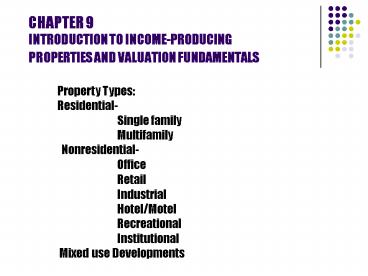CHAPTER 9 INTRODUCTION TO INCOMEPRODUCING PROPERTIES AND VALUATION FUNDAMENTALS - PowerPoint PPT Presentation
1 / 16
Title:
CHAPTER 9 INTRODUCTION TO INCOMEPRODUCING PROPERTIES AND VALUATION FUNDAMENTALS
Description:
Expense Pass-Throughs - if tenant (s) lease only a portion of the building ... rent increases or tied to CPI, may be net leases or expense pass-throughs. ... – PowerPoint PPT presentation
Number of Views:85
Avg rating:3.0/5.0
Title: CHAPTER 9 INTRODUCTION TO INCOMEPRODUCING PROPERTIES AND VALUATION FUNDAMENTALS
1
CHAPTER 9 INTRODUCTION TO INCOME-PRODUCINGPROPER
TIES AND VALUATION FUNDAMENTALS
Property Types Residential- Single
family Multifamily Nonresidential- Office
Retail Industrial Hotel/Motel Recreational
Institutional Mixed use Developments
2
Regional Economic Influences on Property Values
when undertaking a real estate analysis, the
analyst must identify the regional economic
drivers and make a judgment about whether these
drivers will provide a source of growth or
decline in a region.
Why do certain kinds of economic activity tend to
cluster more in some regions and urban areas
than others?
3
Comparative Advantage
Comparative Advantage- some geographic regions
have a comparative advantage over other regions
in that certain goods/services can be produced
more efficiently and profitably in that region
than in other regions.
Reasons Transportation Natural
Resources Climate Leadership Labor
Force Educational Skills
4
Economic Base Theory
Many analysts rely on employment data to evaluate
a regions comparative advantage. One widely
accepted approach in regional economic analysis
is to calculate what are referred to as location
quotients for a region. (Regional Employment
in a particular sector/Total Regional
Employment) (U.S. Employment in a particular
sector/Total U.S. Employment) If this ratio is
greater than 1, then the sector would be
identified as a base or driver industry for a
region because it employs a greater than
proportionate amount of workers in that industry
than is the case for the U.S. as a whole.
5
Economic Base Theory
Employment Multipliers- Used to estimate how
total employment in the region is affected by
changes in base employment. Relate total
employment to base employment, calculate the
ratio estimate increase in base employment
estimate the increase in total employment. Using
this type of macro analysis can help real estate
investors identify the potential demand for
various types of real estate.
6
Supply and Demand Analysis
7
(No Transcript)
8
Location and User-Tenants
Successful real estate investors and developers
realize that location as viewed by user-tenants
is also important to recognize. They must
understand the business operations of potential
tenant-users and how certain locations will
appeal to those users.
This process of profit analysis and competition
by many different firms for space in locations
that tend to maximize profits produces certain
general land-use results in real estate markets.
9
(No Transcript)
10
Lease or Purchase ?
Most tenants find leasing to be more
cost-effective than owning. Why? Owning
requires a large commitment of capital
Owning puts the user in the real estate
business Owning may reduce operating
flexibility Owners must operate, maintain,
and repair the building
11
Chapter 9 - ContinuedIntroduction to Leases,
Projecting Cash Flow and Investment Value
12
Leases Longer terms than 1 year normally
- Base Rent - specified dollar amount of initial
lease. - Step-Up Provision - specify that rents will
increase (step-up) periodically by predetermined
amounts over term of lease. - CPI Adjustment - periodic increases tied to CPI
(protects landlord against inflation. - Percentage Rent - Landlord shares in tenants
sales - typical for shopping centers -
Adv/Disadv? - Share in Gross, net, are what?-
verifiable? - Min (called overage) - can be
sliding scale.
13
Who covers expenses on building? (property taxes,
insurance, utilities, maintenance)
- Gross Lease - Lessor (landlord) pays all expenses
-gtrisky on L-T Leases that dont have escalation
clauses. - Net Leases - Lessee pays some or all of the
expenses - - Net - property taxes
- Net-Net - property taxes property insurance
- Triple Net - property taxes, insurance and
maintenance. (or all expenses
except debt service.
14
- Expense Stops - Lessor pays operating expenses up
to a specified amount, then expenses
pass-through - Expense Pass-Throughs - if tenant (s) lease only
a portion of the building --gt their proportional
share pass-through.
15
Lease Considerations/Concessions
- Free Rent - used in tough times, high vacancy
rates --gt Get them in the building and hope you
can keep them. - Tenant Improvements lessor usually pays for
improvements. - Face Rents/Asking Rents - Quote standard rates
before discounts are given. - Rent Premium or discounts- based on unit location
- Signage
- Non-Compete Clauses
- Lease renewal options - allows tenant to lock
space in future at specified rate. - Right of First Refusal
- Tenant Relocation Option - allows lessor to move
tenant within building during lease terms - Everything is negotiable!!
16
Lease Terms by Property Types
- Hotel/Motel daily/weekend/weekly - the ultimate
inflation protection - Apartments 6/12 month terms, renegotiated at end
of lease term. - Office 3-5 years, options possible, may include
rent increases or tied to CPI, may be net leases
or expense pass-throughs. - Retail vary considerably, smaller
retailersshort terms (1-2 yrs.), larger
retailers (1-20 yrs.). Malls often percentage
leases with floors. - Industrial Highly individualized. 3-5 years or
longer. Typically triple-net leases.































